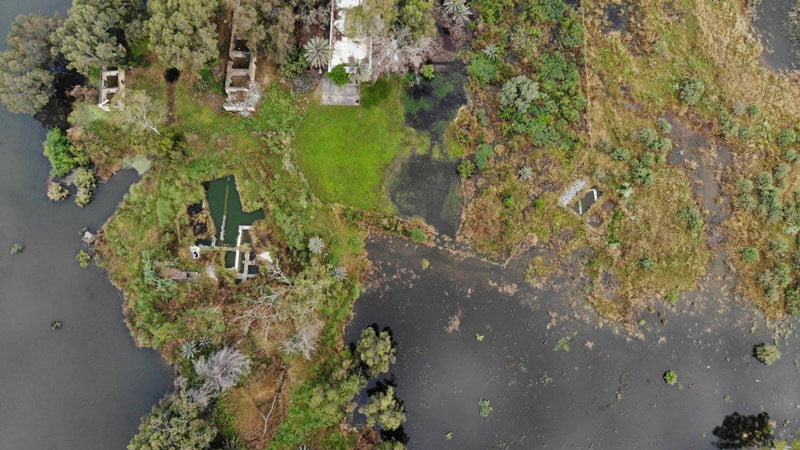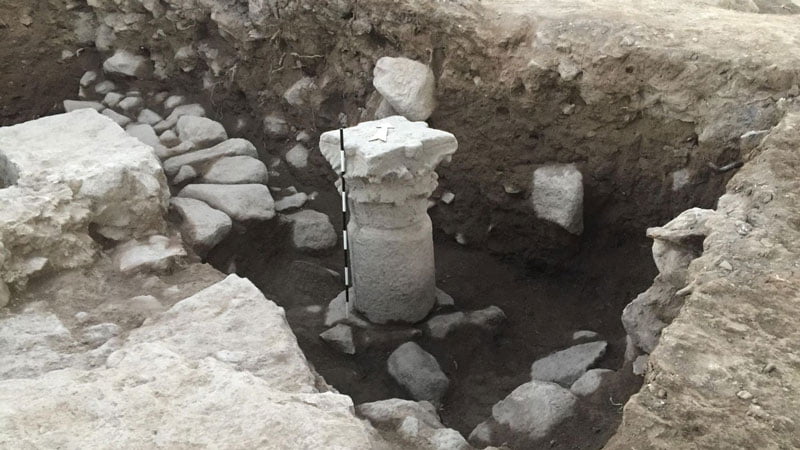Dr. Carrie Wood Digs for Biblical Truth

In the summer of 2013, Dr. Carrie Wood, an instructor in the School of Divinity at Regent University, looked upon the Israeli archaeological site called Khirbet et-Tell with confusion. It was believed to be the site of Biblical Bethsaida for years, but over a kilometer from the lake, she struggled to see how it could be considered a fishing village. Her instructor pointed toward a crop of Eucalyptus trees on the shore of the Sea of Galilee and suggested that this alternate site, El Araj, was the actual location of Bethsaida.
Almost a decade later, El Araj has been excavated and offers biblical promise. Wood has had an ongoing part in the project since it began and shared with Regent the most recent developments in the groundbreaking archeological project and what they mean to her.

Regent University: How did this project begin at El Araj?
Dr. Carrie Wood: In May 2014, a shovel survey was done by a team of professors and students from North Central University and Kineret College on the Sea of Galilee, under the direction of archaeologist Mordechai Aviam of the Institute for Galilean Archaeology and Marc Turnage, then director for the Center for Holy Land Studies. That shovel survey was enough to constitute further digs. In 2016 the first season of excavation began at the site, with R. Steven Notley and Nyack College sponsoring the excavation.
The 2017 Season 2 of the excavation continued with Aviam and staff surrounded by participants from America and Hong Kong. I was a Ph.D. student at Regent School of Divinity, and it was during this dig season that I finally was able to sink my own hands into the soil, carry buckets of dirt, lug wheelbarrows, sift for hidden treasures in the soil and work to find the lost city.

Regent: Briefly describe your findings at El Araj.
Wood: During the summer of 2017, the dig squares began to reveal Crusader period (12th century AD) remains of a sugar factory, leading to a lower level of Byzantine period (4th – 7th century AD) pottery and a coin. In another area of the dig site, levels below the Byzantine period revealed 30 coins. Beneath that layer, the crew uncovered Roman period pottery (1st – 3rd century AD) and bricks from a Roman public building. Mosaic tesserae began to be uncovered in style similar to the mosaics found in the 1st-century synagogue found at Magdala.
In 2019, the southern room of a church was exposed, evidenced by ornate mosaic floors and gold gilded glass tesserae that had belonged to a wall mosaic. With the new evidence, the team knew where the church should be.
What followed was a year of unprecedented rain in Israel which flooded the site and prevented teams from digging, and then the COVID pandemic.

Regent: What was the most recent development?
Wood: In October 2021 a press release went out from Israel that the team of archaeologists had uncovered the mosaic floors of the basilica. The excavation was closed to outside volunteers and students due to the pandemic but the excavation, known now as the El Araj Excavation Project, continued with local students and workers. It was sponsored by the Center for the Study of Ancient Judaism and Christin Origins (CSAJCO) and the Museum of the Bible in Washington D.C. The uncovered mosaics reveal two inscriptions that identify people and will lead to further excavations.
Regent: What does this project mean to you?
Wood: The site is amazing as you stand on the shore of the Sea of Galilee and connect with the land of the Bible. It is such a privilege to dig and sift to reveal the ancient world and to see the centuries unveiled. This site is remarkable with the different layers revealing treasures, and the revelation of a fishing village turned Roman city is breathtaking. (Philip the Tetrarch converted it to a Roman City in 30 AD and renamed it Julias.)
“Holding a coin or looking at Mosaics connects you a bit to those who walked and lived there.”
Regent: Does this discovery confirm anything scripturally?
Wood: This discovery is part of the ongoing conversation of where Jesus walked in Israel. Archaeology is constantly reinforcing Scripture and the Land itself is revealing the truth and evidence of Scripture.

Regent: How does El Araj strengthen your faith and walk with God?
Wood: For me, the El Araj experience began when I first looked at the site from a hill above it at Et-Tell and questioned the evidence. My faith was challenged that summer, and the following study trips to Israel to walk the Land, experience Scripture in the Land, and become familiar with all that it was giving to reveal God to us. The Land is a living voice from Scripture, and it still speaks to us and reveals God’s marvelous treasure. Every time I follow the Ancient of Days on the ancient paths, I marvel.
Regent: How does this discovery impact or contribute to your work at Regent?
Wood: El Araj, which is showing itself to be Biblical Bethsaida, directly impacts my work in the Gospels as I teach at the School of Divinity. Being on the site and walking the land gives greater depth to my study of Scripture and research, leading to a contagious passion in teaching.
“Being able to talk about Jesus in His time and space with greater clarity and understanding means that I am able to open Scripture and speak to His glory and the power of the Gospel of Jesus Christ.”
Regent: What are some next steps you will take on this archeological journey?
Wood: I am praying that the summer of 2022 will see open borders for travel into Israel and a Dig Season in which more of El Araj will be revealed and her treasures shared with the world. El Araj will carry my attention, and I pray that I will carry her dirt in buckets for many years.
About Dr. Carrie Wood
Dr. Carrie Wood serves as an instructor in Biblical Studies for the Regent University School of Divinity. She holds a Ph.D. in Renewal Theology with a focus in Biblical Studies, an M.Div. from Regent University with a concentration in Biblical Studies, and a B.Th. in Messianic Jewish Studies from The King’s University.
Wood fulfilled CPE and served as a hospice chaplain before pursuing her Ph.D. She considered her time with hospice families as some of the most sacred and important work of her journey. She has distinguished herself as an educator on multiple continents, in both civilian and military settings, and works for Biblical Expeditions as an instructor in the lands of the Bible.
RESEARCH INTERESTS
Geography of Scripture
Second Temple Period & Economic Patterns
Archaeology of Israel, esp. the Dig at El-Araj
Ancient Judaism and Early Christianity

